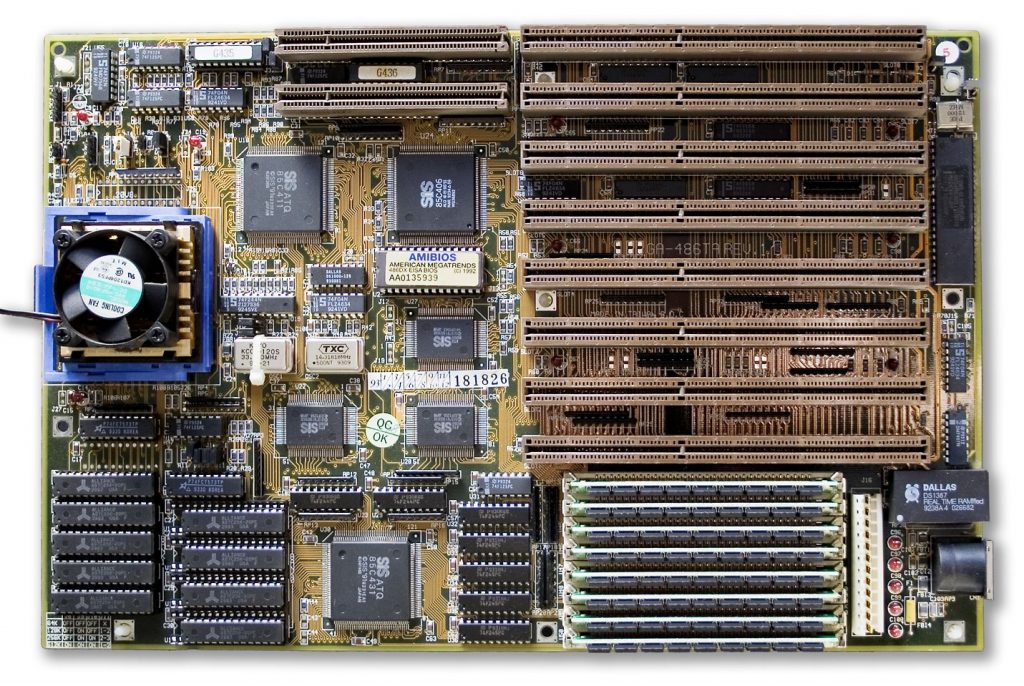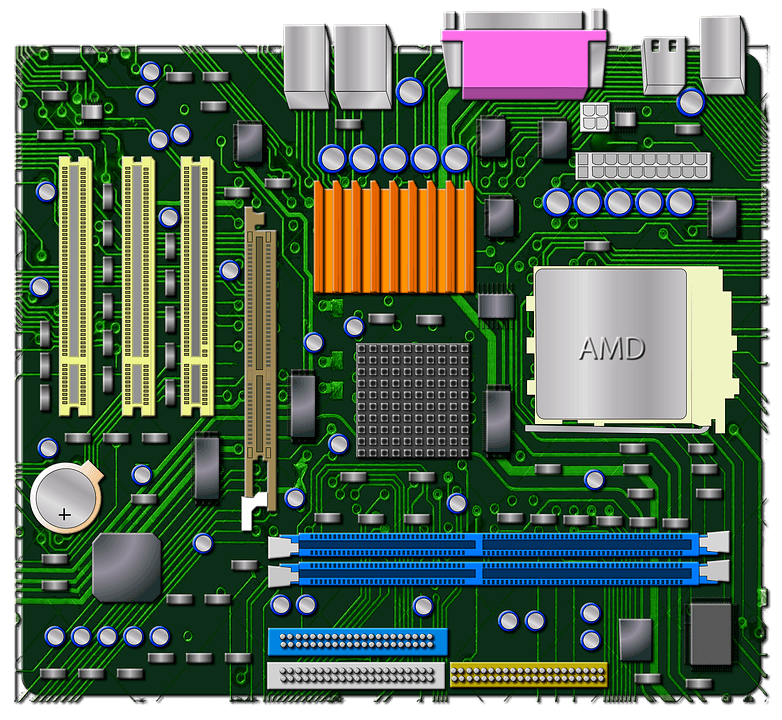A Computer Motherboard is designed on a piece of PCB (Printed Circuit Board) it holds all the major components such as RAM Slots, CPU slots, Expansion slots, BIOS, capacitors, Resistors, SATA, and IDE Slots.
They are also called MAIN BOARD, SYSTEM BOARD, MB, MOBO, etc Mainboard is the primary device in a computer system as every component used is connected to it using cables and wires and therefore it is considered the Backbone of the personal computer system.
There are different types of Computer motherboards used which are differentiated by their Size, functionality, speed, and compatibility with CPUs (Processors).
Different motherboards are designed and developed for specific tasks and for special purposes. Some are developed for Home use,
Some are developed for commercial use, and some Which support high-speed CPUs are used for Research and Educational Purposes.
They are also called as “Heart of Computer” For better understanding, you should be familiar with the functionality and should also be aware of its basic structure & components Used in the main board or logic board.
When you are familiar with the basic functionality and uses of Its components it will help you to build your computer.
Also Read - What is a Motherboard?
- What are Common Motherboard Form Factors
- How to Identify What Motherboard Do I Have?
- What is a CPU [Microprocessor] In Computer
Different Types of Motherboards
With the advancement in technology, computer motherboards have been dramatically changed they differ in shape, size, compatibility, and the capacity to hold the CPU.
Many big companies manufacture MB these days as many manufacturers follow some common guidelines such as placement of CPU Sockets, RAM slots, Expansion slots, USB, IDE, SATA Ports, and connectors these guidelines are called FORM FACTOR.
But some manufacturers produce their Motherboards such that they can be installed on their own computer cases.
Where you have to contact their Authorized dealer for up-gradation or replacement of any damaged part.
Companies that manufacture MB keeping common FORM FACTOR in mind throw intense competition in the computer market.
ATX Form factor has dominated the PC world which possesses some common guidelines and has made its position strong compared to another form factor which is described below.
Different Motherboard Types of Computer
Different Motherboard comes with different form factors but the common form factors are AT and ATX
Different form factors depend upon size, shape, compatibility, and capacity For Example:: an AT Motherboard can be installed in a specific case that supports an AT motherboard, You will not be able to install an ATX Motherboard in an AT cabinet.
You must have some knowledge and awareness of MB’s component and its Form Factor before installing or upgrading any component or parts because as the mainboard is an integral part of the Personal computer all Computer peripherals are attached to it directly or indirectly and any misconfiguration can stop your PC from responding.
The common types of Motherboards depending on their Form Factors are
- AT Family (Full AT and Baby AT)
- ATX Family (Full ATX, Micro ATX, FlexATX)
- XT , LPX , BTX ,Pico BTX and Mini ITX MB
AT Motherboards
They are old-style LOGIC BOARDS which has an AT Form Factor. These logic boards were manufactured by IBM in 80’s they dominated the PC Hardware World for a long time.

They were huge and shaped almost double the size compared to other motherboards. At that time it was the newest technology and the size of the components was large to fit.
AT Stands for Advanced technology. They have a PGA Socket (PIN grid Array)socket for CPUs, SD RAM slots,20 Pin power connectors,s and expansion slots(PCI and ISA ) with Keyboard and serial mouse connectors.
Examples are P-III ProcessorsBaby AT Motherboards
They possess both features of XT and AT Form Factors.
These mainboards have PGA Processor Sockets, SD Ram And DDR RAM slots, Expansion slots(PCI and ISA Slots) both 12-pin and 20 pins power connectors with Big Keyboard ports called DIN and Serial mouse port.

As the computer hardware industry has grown the demand for smaller computers grew drastically the manufacturer developed and built smaller LOGIC BOARDS which require small space for installation.
The AT MB with AT Form Factor required huge size computer cases for installation Therefore small MB named ‘BABY AT ‘ were manufactured.
These BOARDS with AT form factor became popular and dominated the PC Industry for a while.
Before they had only a keyboard connector which was called DIN and a monitor would be connected to it but if you needed to add more devices the expansion slots were available to install add-on cards for the use of more features and better functionality.
Eamples are Pentium-III and Pentium-IVFull ATX
ATX Stands for Advanced Technology extended these motherboards have the features of ATX Form factor.
They have an MPGA CPU socket, DIMM slots for RAM, Expansion slots (PCI, ISA, AGP), SATA, and IDE connectors with ports and connectors 12 pins and 20 pin power connector are available in these types of motherboards.

ATX MB was small in size compared to AT Form Factor motherboards. At that time they were hugely popular and ruled the PC Hardware industry.
They were more powerful compared to others and required less space for installation. They were so popular that they made their standards and ATX Form Factor was hugely used and was made popular because of its silent features.
This ATX MB had some extra features and components pre-installed into it. Examples are Pentium-IV, Dual-Core, Core 2 Duo, Core 2 Quad, Quad-Core, i3, i5, and i7 Processors
Some of the latest ATX Motherboards for i7 8700k can be found here.
Micro ATX
As computer Technology developed the computer market changed and the demand for small and powerful MB was huge in numbers.
They were developed using the same ATX form Factor in mind as the price of this MB was low the demand increased rapidly.
They had 3 to 4 expansion slots but the features of this motherboard were similar to ATX form factor main boards. These types would fit in small computer cases with ATX form factor.
Flex-ATX
These types of motherboards are not as popular as other ATX Form Factor mainboards.They are considered to be the smallest in the ATX Family.
They were developed in small size and were low in cost. Flex ATX is a variant of micro ATX and was developed by Intel in the year 1999 -2000.
XT
XT Stands for Extended Technology. They are a very old type of LOGIC BOARD which has 12 pins connectors, RAM slots expansions slots (ISA) Using an old model processor with LIF (Low Insertion Force).
For use of more features expansion slots are available for add-on cards and some ports are available for additional features. They are typically slot-type processors.
Example:: Pentium-I, Pentium -II, and Pentium-II Processors.BTX Motherboards
BTX stands for Balanced Technology Extended. The first company which used BTX was Gateway later followed by Dell and Apple.
Pico BTX Main Boards
Pico BTX SYSTEM BOARDS are very small in shape and size and use the BTX Form factor. They are very small in size and hence called Pico BTX.
Also Read - What is Operating System and Its Different Types
- What is Dos Operating System
- How to Create a Bootable USB Pendrive
- What is a Computer Password
- How to Reset BIOS Password
- Computer Basic Tutorials
Classification on the Basis of Type of Processor
A Computer motherboard can be classified based on the processor they use. Or the motherboards that are compatible with certain CPUs or processors.
They are categorized using the different types of sockets they use. For example, the processor that is compatible with socket A type is not compatible with socket T system boards.
Therefore you must recognise or detect which type of processor socket your SYSTEM BOARD has it is a very important aspect when you are going to upgrade your system configuration i.e upgrading your CPU or replacing your processor with an appropriate Processor that matches or that is compatible with your MB
Now in this tutorial, we are going to discuss some common types of sockets which are available on MOBO so if you find it necessary to upgrade your processor you will not find any difficulty in doing so.
Socket A
The socket A motherboards are also called socket 464 motherboards. They are compatible with AMD processors. The CPU socket has 462 pins and it has a PGA (Pin Grid Array.)
They support or are compatible with Intel PIII, Celeron, and Cyrix processors.
Socket 378
These types of motherboards are commonly called Socket N motherboards. They support Intel P4, Intel Pentium M, and Intel Pentium 4EE processors which have 478 pins of PGA (Pin Grid Array) Type /p
Socket T
Socket T motherboards are also called LGA 775, this type of processor supports or is compatible with Intel Core 2 Duo, Intel Dual Core, Intel Core 2 Quad, Celeron, P4, Pentium D and Celeron D types of processors.
This processor has 775 pins using PGA (Pin Grid Array)
Socket 939
This socket has 939 pins and is specially designed for AMD processors and their families.
This processor comes with a PGA (Pin Grid Array) and supports processors like AMD Athlon 64, Athlon 64, and various AMD processors.
Socket AM3
These are the types of MB’s which are very famous nowadays which has 941 pins with PGA and supports AMD Phenom !! And AMD Athlon II processors.
Socket H or LGA 1156
These are the advanced level of SYSTEM BOARDS that support CPUs like Intel Core i3, Intel Core i5, and Intel Core i7.